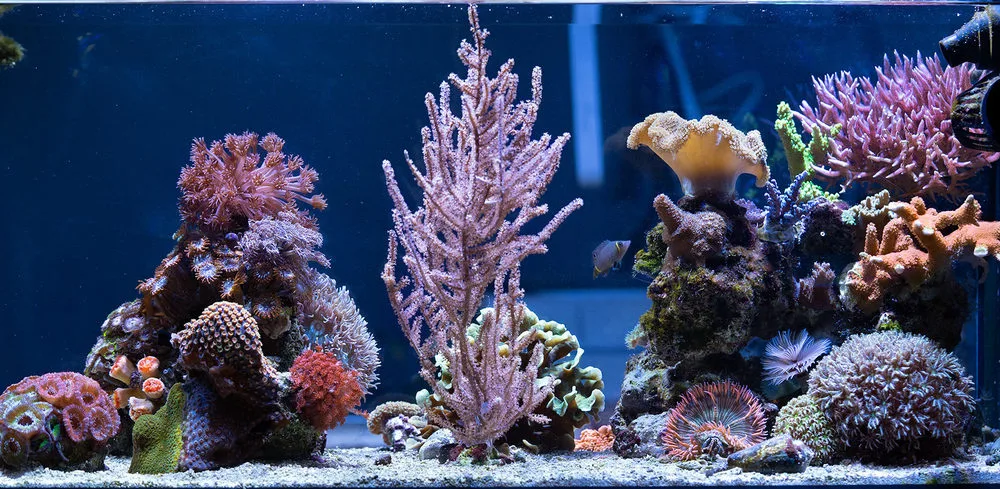Stunning 20-Gallon Reef Tank – Lizzyann's TOTM | NanoReef

Tank Specifications
Volume: 20 Gallons / 75 Liters
Dimensions (L × W × H):
30.0" ×
12.0" ×
13.0"
76.2cm ×
30.5cm ×
33.0cm
Equipment List
- Salt: Tropic Marin
Frequently Asked Questions
What type of lighting is recommended for a nano reef tank?
The IM 20 Peninsula Nano Reef uses 2 AI Prime HD lights, which provide suitable light spectrum for coral growth and are adjustable for different needs. For similar setups, consider lights that can be dimmed and offer different color spectrums.
How do I maintain water temperature in the tank?
Using a Cobalt Neo-therm 100 watt heater in combination with a good thermometer helps maintain consistent temperatures in your reef tank. It's recommended to keep the heater set to 77-78°F for optimal coral health.
What filtration system is best for a small reef tank?
The tank uses an IM CustomCaddy filtration system, which includes filter floss and Chemi-pure Blue media. This combination helps maintain water clarity and quality. Regular replacement of filter media will help prevent the buildup of harmful substances.
What is the recommended feeding schedule for corals and fish in the tank?
Feeding once a day with Cobalt Aquatics Marine Omni flakes or Reef Nutrition TDO pellets for fish is recommended, while corals like LPS and NPS should be spot-fed with frozen foods every other day using a pipette.
How often should I perform water changes, and how much water should I change?
You should perform a 10%-20% water change weekly using RO/DI water and a quality salt mix like Tropic Marin Pro Reef. This regular maintenance helps reset nutrient levels and improves water clarity.
What should I do about pest control in my reef tank?
Manually removing nuisance algae or pests like vermetid snails with tweezers is recommended. Keeping a diverse tank with various clean-up crew members (like crabs and shrimp) can also help manage pests.
How often should I test the water parameters in my nano reef?
Initially, testing nitrate and phosphate weekly, and calcium, alkalinity, and magnesium every two weeks is a good start. As the tank matures, you can reduce the frequency of tests, but maintaining weekly checks on calcium and alkalinity is advisable.
What are the ideal water parameters for a successful reef tank?
Aim to maintain alkalinity at 8.5 dKH, calcium at 440 ppm, and magnesium at 1350 ppm. Regular testing and adjustments using dosing solutions like BRS soda ash for alkalinity and calcium chloride for calcium will help maintain these levels.
How do I choose compatible fish for my reef tank?
Selecting peaceful and unique fish like the Yellow Banded Possum Wrasse, Yasha Goby, and Randall's Assessor Basslet can enhance the biodiversity of your tank. Ensure that they share similar water parameter requirements and consider their territorial behaviors.
What corals are suitable for a beginner in a nano reef setup?
Soft corals like Zoanthids and Fiji Yellow Leather, and hardy LPS corals like Duncan and Acan Lords are great for beginners. They are forgiving of water quality fluctuations and offer vibrant colors.
What is the best way to prevent fish from jumping out of the tank?
Installing a lid on your tank is crucial, as fish can and will jump. DIY options can be visually appealing and are often straightforward to implement.
How can I keep a maintenance journal for my tank?
Keeping a written journal or using apps like Aquarimate can help track test results, maintenance routines, feeding schedules, and changes in the tank's health. This records are invaluable for troubleshooting future issues.
What are some common challenges with a nano reef, and how can I address them?
Common challenges include nutrient imbalance and algae blooms; addressing these can involve adjustments to feeding, regular water changes, and careful monitoring of parameters. Building biodiversity in your tank also fosters a more stable ecosystem.